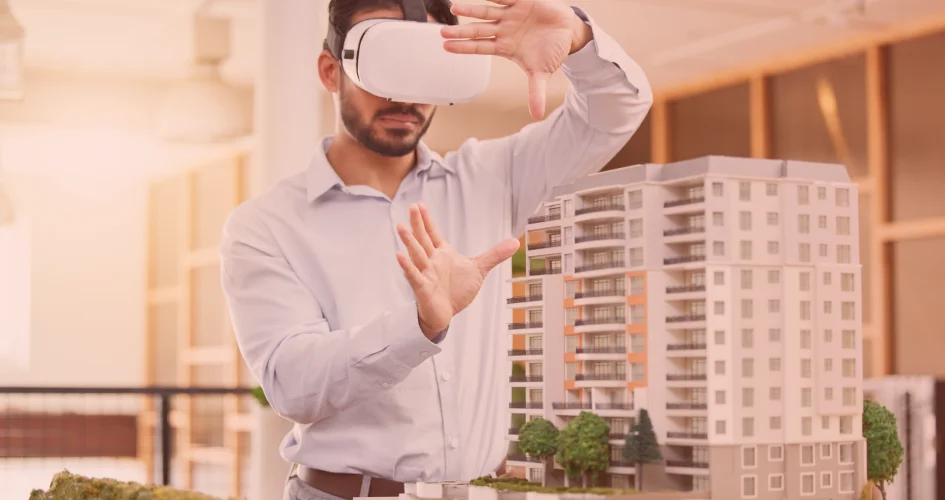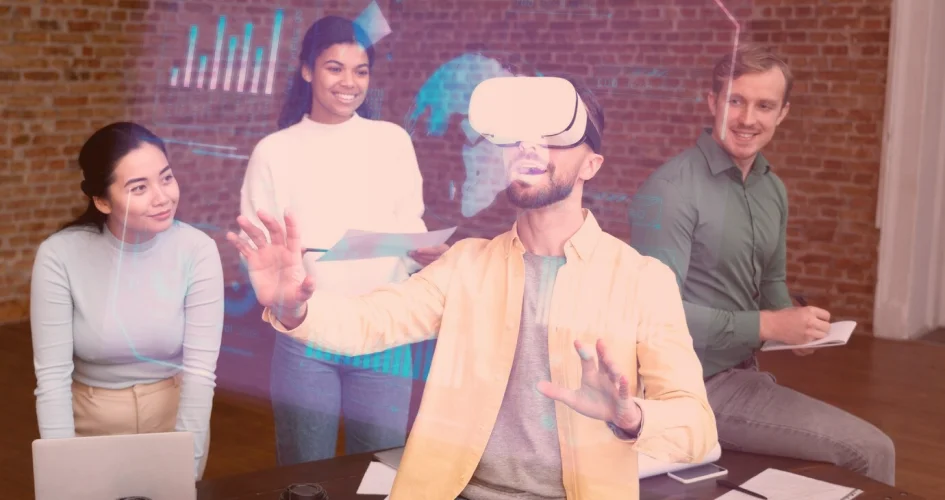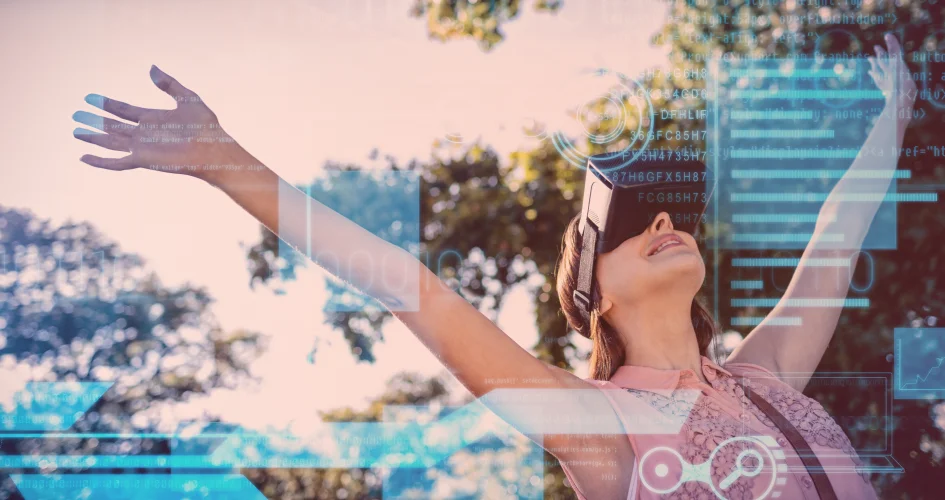The use of Augmented Reality for Education is opening doors to innumerable possibilities.
For one, it provides opportunities to adopt hands-on learning approaches to help students practice new skills, and increase engagement.
It does this by introducing digital characters to real-world illustrations and simplifying many confusing grey areas in complex topics.
From virtual human body models to 3D textbooks, Augmented Reality can introduce learners to an immersive learning experience.
Interested in developing a solution to Augmented Reality in Education?
Then continue reading to garner some AR app ideas for learning platforms.
We’ll discuss the following here:
- Ways different sectors use Augmented Reality for learning
- Real-life examples of Augmented Reality for schooling
- How to get started with creating your AR solution
- And more:
Let’s start the discussion by delving into how different sectors learn via Augmented Reality.
How AR is Used for Education in Different Sectors
Continuous workforce re-education is the primary pillar of many organizations as innovation introduces new technologies to all sectors.
As such, most companies have a dedicated department for expanding the skillset of their labor force.
For effective education, organizations across diverse niches have adopted AR-based learning.
Augmented Reality for Classrooms
Students, especially those below 16 years, need pictorial descriptions to appropriately understand complex topics.
AR creates the perfect tool for this by giving students a 3D illustration of objects.
This way, students can explore theoretical concepts visually.
The immersive experience through AR helps reinforce information and incorporates all five senses as students virtually engage with objects.
As a startup founder, you can create AR solutions for any subject, including history, zoology, programming, geometry, etc.
Let’s check through some examples of AR tools for classrooms:
Assemblr
Assemblr is an AR tool that empowers learners to learn from illustrated images and can also create new content themselves.
It’s an excellent tool for learning about ocean animals, fractions, symmetry, planets, animals, and even how to solve maths questions correctly. The software has free and paid school plans that cost $1/month for each student.
Quiver Masks
Quiver Masks is a fun AR-powered tool for students to create and put themselves in the shoes of story characters.
For example, a kid can retell and record the Cinderella story; while others see her as that character.
It’s a highly effective tool for role-playing.
Arloon Chemistry
This AR-powered app eases the process of learning chemical formulae and viewing the shapes of compounds.
Augmented Reality’s immersive experience helps them learn the complex aspects of chemistry in easy-to-understand ways.
Augmented Reality for Space Training
Astronauts require significant training about their spacecraft and outer space before embarking on the journey.
Due to the difficulty of this job, NASA deploys modern technology to drive understanding among astronauts and other crew members.
AR aids them in simulating parts of the aircraft and other foreign bodies they might encounter.
Augmented Reality makes it easy for engineers and astronauts to:
- Maintain the space capsule and station
- Explore planetary surfaces via AR glasses
- Read manuals via AR glasses, eliminating the need to carry extra documents.
AR for Medical Training
Medical Education entails learning and retaining enormous amounts of information on body biochemistry, human anatomy, and pharmacology.
Augmented Reality makes this process easy through concepts like virtual cadavers.
Virtual cadavers are immersive views of the human body where complicated blood vessel paths and branching nerves that would have been taught theoretically are visually examined.
Studying specific parts is done by selecting the area of interest and zooming into its features.
Here are other ways AR transform Medical Education:
- Creating virtual training environments via simulations
- Learning by practice on virtual patients
- AR videos to educate physicians on new tools and methodologies.
Some examples of AR for medical training are:
HoloHuman
This app uses immersive, full-size holograms to let educators and students explore regions of the body.
HoloHuman allows users to view different body systems and zoom in on over 4000 structures.
The app allows users to dissect and drill down into organs, regions, and body parts.
Human Anatomy Atlas
The Human Anatomy Atlas is an easy-to-use 3D human body reference tool.
It has full male and female body models and offers an inside view and diagnostic images of the carcass.
Users can study different organs at varying levels, access over 120 histology slides, and a section on brief illustrations and animations about common conditions synonymous with each organ.
Touch Surgery
Touch Surgery is a software that lets users prepare, practice, and teach surgical procedures via Augmented Reality.
It simulates a surgical process for users to perform practical tests and brush up on their knowledge through the app’s tips and guides.
Augmented Reality for Military Education
The military requires consistent training to keep up with new weapons releases, change warfare environments, and quickly adapt to new environments.
However, putting boots to the ground to train in new locations may be impossible, and where possible, they are expensive.
However, with Augmented Reality, this can be done cheaply
AR helps simulate the ideal environment for training without much financial and human sacrifice.
The technology can mimic live combat by simulating digital vehicles, enemies, and the perfect scenario.
Let’s consider an example of an AR-powered tool for military training:
Augmented Immersive Team Trainer
Augmented Immersive Team Trainer is a lightweight system that users can carry anywhere, simulate any environment, and prepare for real-world battle situations.
AIIT uses Augmented Reality to superimpose virtual objects in a natural setting.
It uses virtual aircraft, ammunition, and vehicles. The technology can support different virtual, live, and advanced training procedures.
AR offers numerous benefits for military training via:
- Providing less hazardous training conditions
- Cheap training
- Ability to mimic any environment.
Augmented Reality for Manufacturing Training
Traditional training in the manufacturing industry requires physical documents and heavy machinery.
While these methods are effective, they often impact production by diverting tools and equipment to the training arena.
Additionally, human errors make learners prone to injuries.
With Augmented Reality, manufacturers can train their staff independently, interactively, and visually without the possibility of injury and production-time loss.
AR makes this possible by superimposing training elements and allowing employees to perform real-time training activities.
It can also alert students to mistakes and provide better performance tips.
Research by Delliotte suggests that the manufacturing industry will need more than 2.4 million workers due to technical skillset shortages. AR can prevent this by reducing training costs and providing an ideal environment for quick assimilation.
With your newly acquired knowledge of some use cases for AR, you’re probably fired up to join the “league of Education Augmented Reality app owners.”
Before you start creating your product, it’s best to read this article on the cost to build an augmented reality education app.
What’s more? Let’s further lay down the benefits of using AR for education.
Pros of Using Augmented Reality to Teach
AR in Education at all levels encourages interactivity and engagement without some nuances synonymous with physical practical training.
Its introduction to learning has improved students’ assimilation rate as they can now have a 3-D view of theoretical and complex explanations.
Below is a short exposé on the benefits of AR to learning:
Benefit 1: Safe Learning Environment
Industries in hazardous fields can use AR to teach new employees without exposing them to harmful chemicals.
Through AR superimposition, they can virtually handle dangerous items and have some sort of real-life experience before being involved in the actual process.
Benefit 2: It makes Learning More Exciting and Interactive
Through 3-D models, AR technology can bring textbook characters more visualizable and interactive, making learning engaging and fun.
Benefit 3: Improves Retention
AR technology makes it easier for students to assimilate by providing a visual and interactive description of what’s being studied.
In high-quality 3-D AR models, students can touch, see, and examine objects in real-time, making remembering what they’re taught easier.
Benefit 4: Real-World Context
Fields like surgery and engineering requires a great deal of practical experience to understand complex processes.
AR provides real-world context by letting students experience difficult concepts highly interactively.
It depicts real-world scenarios and provides them with needed experience right from the classroom.
Benefit 5: Enables Experimentation
Augmented Reality technology can be a valuable tool for Education as learners can explore and experiment in new ways.
For example, medical students use Augmented Reality to simulate and practice complex medical procedures before using a human body.
Engineering students also use AR to experiment with virtual 3D models on complex machinery, enabling them to simulate multiple scenarios and identify design flaws.
In both use cases, it minimizes the risk of loss or damage to human lives and properties.
Build Your Augmented Reality Product with Intelivita
Augmented Reality is a revolutionary innovation still in its early stage.
As with any culture-shaping tool, the best time to create a product, and tap into its rising demand is now.
As such, let’s help you get started right away.
Intelivita is an Augmented Reality app development company with top-notch experience creating high-value AR-powered software for SMBs, startups, and unicorns.
Reach out to us today to learn more about our AR development services.







